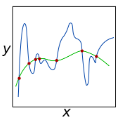The explicit low-rank regularization, e.g., nuclear norm regularization, has been widely used in imaging sciences. However, it has been found that implicit regularization outperforms explicit ones in various image processing tasks. Another issue is that the fixed explicit regularization limits the applicability to broad kinds of images since different images favor different features captured by using different explicit regularizations. As such, this paper proposes a new adaptive and implicit low-rank regularization that captures the low-rank prior dynamically from the training data. At the core of our new adaptive and implicit low-rank regularization is parameterizing the Laplacian matrix in the Dirichlet energy-based regularization with a neural network, and we call the proposed model \textit{AIR-Net}. Theoretically, we show that the adaptive regularization of AIR-Net enhances the implicit regularization and vanishes at the end of training. We validate AIR-Net's effectiveness on various benchmark tasks, indicating that the AIR-Net is particularly favorable for the scenarios when the missing entries are non-uniform. The code can be found at \href{https://github.com/lizhemin15/AIR-Net}{https://github.com/lizhemin15/AIR-Net}.
翻译:在成像科学中广泛采用了明确的低级别正规化,例如核规范化。然而,人们发现,在各种图像处理任务中,隐含的正规化优于显性。另一个问题是,固定的明确正规化限制了对广泛图像的可适用性,因为不同的图像有利于通过不同的明确正规化而获取的不同特征。因此,本文件提出了一种新的适应性和隐含的低级别正规化,从培训数据中动态地捕捉了先前低级别之前的动态数据。在我们新的适应性和隐含的低级别正规化的核心是将基于能源的正规化与神经网络中的拉普拉基亚矩阵作为参数,我们称之为拟议的模型\ textit{AIR-Net}。理论上,我们表明AIR-Net的适应性正规化加强了在培训结束时的隐性正规化和消失。我们验证了AIR-Net在各种基准任务中的有效性,表明当缺失条目为非统一时,AIR-Net对于各种假设尤其有利。代码可以在href{http://githliub.Azrub/Net_Azir15/Netzim_Azu15/ comma15/comemin)上找到。





